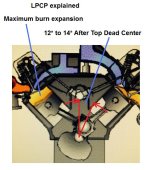centerline
Regular Contributor
after being reading several forums and articles, and being told NOT to use the common stock full dish pistons with vortec heads, so I have been looking for alternatives.
It has also been said that I should locate a a piston/ engine parts supplier that is familiar with marine engines to help decide what I need, but I cannot find a parts supplier who is knowledgeable about marine engines. JEGS is the only supplier who even claims to have someone who is familiar with a marine engine build, and is willing to put together a custom kit for me.... but I dont trust their piston choice, as the photo they sent me shows a narrow quench ring...
in an attempt to find a piston that works, I have searched the internet and have came up with 5 choices of SBC pistons.... I am posting the links in hopes that someone can take a look and tell me if any of these are the style of piston I should be looking for..... some of the choices shown are a bit expensive, and may not even be the right size for my application, but I need help finding the correct STYLE, and then I will locate the correct part number in that style.
the back story is, I have a '99 Vortec 5.7 roller block (68cc heads) that im converting to a 383. I have rebuilt many stock automotive and truck engines (gas and diesel) but this is my first attempt at a marine stroker conversion...or dealing with a vortec engine.
I am not trying to build a 400+hp motor, so i dont feel I need forged pistons, forged crank or H beam rods, but im only wanting to build a dependable motor that will deliver a bit better performance than the stock 5.7, at a reasonable cost....
5 piston choices below...
KB135
KB121
IC734
H890CP
139632-8 .......... Thank you for any help you may be able to give.
It has also been said that I should locate a a piston/ engine parts supplier that is familiar with marine engines to help decide what I need, but I cannot find a parts supplier who is knowledgeable about marine engines. JEGS is the only supplier who even claims to have someone who is familiar with a marine engine build, and is willing to put together a custom kit for me.... but I dont trust their piston choice, as the photo they sent me shows a narrow quench ring...
in an attempt to find a piston that works, I have searched the internet and have came up with 5 choices of SBC pistons.... I am posting the links in hopes that someone can take a look and tell me if any of these are the style of piston I should be looking for..... some of the choices shown are a bit expensive, and may not even be the right size for my application, but I need help finding the correct STYLE, and then I will locate the correct part number in that style.
the back story is, I have a '99 Vortec 5.7 roller block (68cc heads) that im converting to a 383. I have rebuilt many stock automotive and truck engines (gas and diesel) but this is my first attempt at a marine stroker conversion...or dealing with a vortec engine.
I am not trying to build a 400+hp motor, so i dont feel I need forged pistons, forged crank or H beam rods, but im only wanting to build a dependable motor that will deliver a bit better performance than the stock 5.7, at a reasonable cost....
5 piston choices below...
KB135
KB121
IC734
H890CP
139632-8 .......... Thank you for any help you may be able to give.
Last edited:


